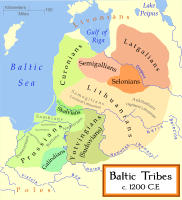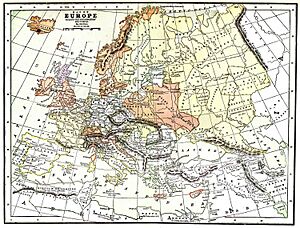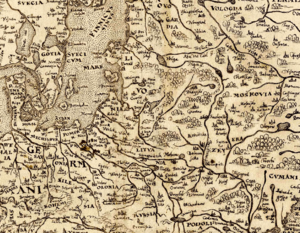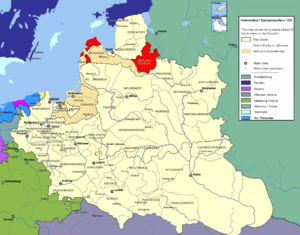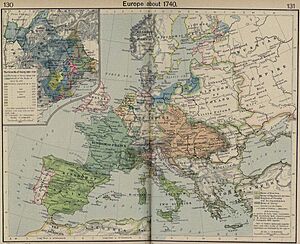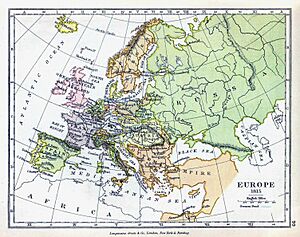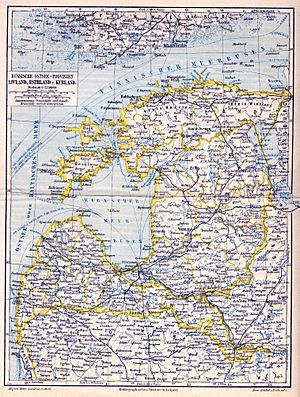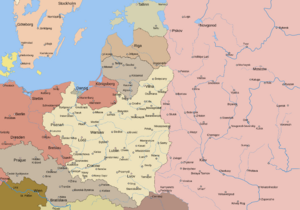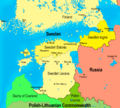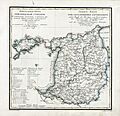Livonia facts for kids
Livonia, also known as Livland, is a historic area on the eastern side of the Baltic Sea. It got its name from the Livonians, a group of people who lived along the coasts of what is now Latvia.
By the end of the 1200s, the name Livonia covered most of present-day Estonia and Latvia. This happened after the Livonian Brothers of the Sword conquered these lands during the Livonian Crusade (1193–1290). Medieval Livonia, also called Terra Mariana, grew even larger after the Saint George's Night Uprising in 1343-1345. This uprising made Denmark sell its northern Estonian lands (the Duchy of Estonia) to the State of the Teutonic Order in 1346. After Denmark left, Livonia stretched from the Gulf of Finland in the north to Lake Peipus and Russia in the east, and Lithuania in the south.
However, the Livonian War (1558–1583) changed things. After this war, Livonia's territory became smaller, covering only the southern part of Estonia and the northern part of Latvia.
The first people to live in Livonia were different Finnic tribes in the north and Baltic tribes in the south. Later, the descendants of the crusaders who came during the Livonian Crusade became the new leaders of Livonia. They eventually became known as the Baltic Germans.
Contents
- Livonia's Journey Through Time
- The Livonian Brothers of the Sword (1204–1237)
- The Livonian Crusade (1198–1227)
- The Monastic State of the Teutonic Knights (1237–1561)
- The Livonian Order (1237–1561)
- The Livonian Confederation (1418–1561)
- The Livonian War (1558–1583)
- The Duchy of Livonia (1561–1621)
- The Kingdom of Livonia (1570–1578)
- Swedish Livonia (1629–1721)
- The Livonian Voivodeship (1620s–1772)
- The Riga Governorate (1721–1796)
- The Governorate of Livonia (1796–1918)
- Governors-General of Estonia, Livonia, and Courland (1845–1876)
- Vidzeme in Independent Latvia (1918–1940)
- Livonia Today
- Images for kids
- See also
Livonia's Journey Through Time
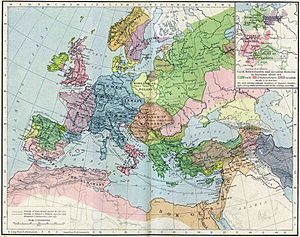
Starting in the 1100s, Livonia became a target for expansion by Danes and Germans. They were especially interested in trade through groups like the Hanseatic League.
Around 1160, traders from Lübeck (a German city) set up a trading post where the city of Riga would later be built. Bishop Albrecht von Buxthoeven officially founded Riga in 1201. He ordered a large church (cathedral) to be built in 1215 and became the first Prince-Bishop of Livonia.
The Livonian Brothers of the Sword (1204–1237)
Bishop Albert of Riga created a military group called the Livonian Brothers of the Sword in 1202. The Pope approved this group in 1204. Its members were German "warrior monks." They were also known as the Christ Knights or Sword Brethren.
The Bishop founded this group to help convert the local pagan people, such as the Curonians, Livonians, Semigallians, and Latgalians, who lived around the Gulf of Riga. However, the Order often ignored the bishops and acted on its own.
In 1218, Bishop Albert asked the King of Denmark, Valdemar II of Denmark, for help. But Valdemar made a deal with the Brotherhood instead and conquered northern Estonia for Denmark. The Brotherhood's main base was at Fellin in present-day Estonia. Its castle walls still stand today. Other important strongholds included Wenden, Segewold, and Ascheraden.
In 1236, the Brotherhood suffered a major defeat by Lithuanian forces in the Battle of Saule. The remaining Brothers then joined the Teutonic Order in 1237 and became known as the Livonian Order. They continued to operate mostly on their own, led by their own Master.
-
Baltic Tribes, around 1200.
The Livonian Crusade (1198–1227)
The Livonian Chronicle of Henry, written in the 1220s, tells the story of how Livonia became Christian. The King of Germany, Philip of Swabia, gave Livonia to Bishop Albert of Buxthoeven. In 1200, Albert sailed with many ships full of armed crusaders to establish a Catholic territory in the east. This was all part of the larger Livonian Crusade.
The Monastic State of the Teutonic Knights (1237–1561)
After the Livonian Brothers of the Sword joined the Teutonic Knights in 1237, Livonia became part of a larger state ruled by these knightly orders.
Livonia was divided into several parts:
- A state ruled by the Livonian Order (which became part of the Teutonic Knights).
- The Bishopric of Riga (which became an archbishopric in 1255).
- The Bishoprics of Courland, Ösel-Wiek, and Dorpat.
The Livonian Rhymed Chronicle describes how the Germans conquered Livonia.
The Livonian Order (1237–1561)
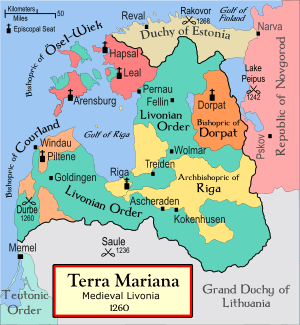
The Livonian Order was a mostly independent part of the Teutonic Knights. It was also a member of the Livonian Confederation from 1418 to 1561. After their defeat in the 1236 Battle of Saule, the remaining Livonian Brothers of the Sword joined the Teutonic Knights as the Livonian Order in 1237.
Between 1237 and 1290, the Livonian Order conquered all of Courland, Livonia, and Semigallia. However, their attack on northern Russia was stopped in the Battle of Rakvere in 1268. In 1346, after the St. George's Night Uprising, the Order bought the rest of Estonia from King Valdemar IV of Denmark.
The Teutonic Order started to decline after its defeat in the Battle of Grunwald in 1410. Its Prussian lands became secular (non-religious) in 1525. But the Livonian Order managed to stay independent.
During the long Livonian War (1558–1582), the Livonian Order suffered a major defeat by Russian troops in the Battle of Ergeme in 1560. They were in great danger. Many European countries warned the Holy Roman Emperor that Russia wanted more than just a few ports in Livonia. They feared that all trade in the North and even Europe itself was at risk.
Because of the religious changes of the Reformation, the distant Holy Roman Empire could not send troops. The Duchy of Prussia also couldn't help much.
In 1570, the Russian Tsar Ivan IV made Duke Magnus the King of Livonia. Other powers did not like this. The Livonian Order decided to seek protection from Sigismund II Augustus, the King of Poland and Grand Duke of Lithuania.
After making a deal with Sigismund II Augustus, the last Livonian Master, Gotthard Kettler, changed the Order into a non-religious state and became a Lutheran. In the southern part of the Order's lands, he created the Duchy of Courland and Semigallia for his family. Most of the remaining lands were taken by the Grand Duchy of Lithuania. Denmark and Sweden took back control of northern Estonia.
From the 1300s to the 1500s, Middle Low German was the main language in Livonian towns. Later, High German became the official language in the 1500s and 1600s.
-
A Livonian lady, painted by Albrecht Dürer.
The Livonian Confederation (1418–1561)
In 1418, the Archbishop of Riga, Johannes Ambundii, brought together the five church-ruled states in Medieval Livonia. These were the Livonian Order, Courland, Ösel–Wiek, Dorpat, and Riga. Together, they formed the Livonian Confederation.
A meeting, or Landtag, was created in 1419. The city of Walk was chosen as the place for these meetings.
The Livonian War (1558–1583)
The Livonian War was a long and complex conflict involving many powers. In 1560, Magnus von Lyffland, who had become a bishop, seemed to have good chances of becoming a ruler in Livonia. He was recognized by several bishoprics and the Livonian Order.
However, when Eric XIV of Sweden became king in September 1560, he quickly got involved. He made peace with Russia and spoke to the people of Reval city. He offered them good deals and also threatened them. By June 6, 1561, Reval submitted to him.
King Eric's brother, Johan, married a Polish princess in 1562. Johan wanted his own land in Livonia. He loaned money to Poland and then claimed castles as his own.
Soon after, Eric XIV lost his allies. Magnus was upset that he felt tricked out of his inheritance. Denmark and Sweden also had disagreements. In August 1561, Frederick II of Denmark made a treaty with Eric XIV. Magnus and his brother Frederick II had big disagreements. Frederick II then made a treaty with Ivan IV of Russia in August 1562 to help his brother get more land and slow down Swedish advances. Eric XIV did not like this, and the Northern Seven Years' War (1563-1570) began. Sweden fought against the Free City of Lübeck, Denmark, and Poland.
In 1568, Eric XIV became unwell, and his brother Johan became King John III of Sweden. Johan III, being friends with Poland, started a policy against Russia. He wanted to gain more land in Livonia and control Denmark.
After all sides were financially exhausted, Frederick II told his ally, King Sigismund II Augustus of the Polish–Lithuanian Commonwealth, that he was ready for peace. On December 15, 1570, the Treaty of Stettin ended the Northern Seven Years' War.
During the Livonian War, some Livonian nobles and townspeople wanted independence. They formed a "Peace Party" and hoped to make a deal with Russia to avoid the war's horrors and prevent Livonia from being divided. Magnus, who represented Denmark and later made a deal with Ivan IV, became a symbol for this group.
In 1575, after Russia attacked Danish claims in Livonia, Frederick II and the Holy Roman Emperor left the conflict. Johan III then paused his pursuit of land for two years to get into a better position. In 1578, he restarted the fight. In 1578, Magnus moved to the Polish-Lithuanian Commonwealth, and his brother mostly gave up his land in Livonia.
The Duchy of Livonia (1561–1621)
In 1561, during the Livonian War, Livonia came under the control of the Grand Duchy of Lithuania. It became a dependent territory of Lithuania. Eight years later, in 1569, when the Grand Duchy of Lithuania and the Kingdom of Poland formed the Polish–Lithuanian Commonwealth, Livonia became a shared territory ruled directly by the king and grand duke.
Ivan the Terrible of Russia faced difficulties by 1579. The Crimean Khanate had attacked Russian lands and burned Moscow. Drought and diseases had harmed the economy, and his policies had disrupted the government. Meanwhile, the Grand Principality of Lithuania had joined with the Kingdom of Poland (1385–1569) and gained a strong leader, Stefan Batory, who was supported by the Ottoman Empire.
Stefan Batory launched three attacks against Russia to cut off the Kingdom of Livonia from Russian territories. In 1579, he retook Polotsk. In 1580, he took Velikie Luki. In 1581, he began the Siege of Pskov.
Frederick II of Denmark and Norway struggled to continue fighting Russia, unlike Sweden and Poland. He made a deal with John III in 1580, giving him titles in Livonia. This war lasted from 1577 to 1582. Russia only recognized Polish-Lithuanian control of the area in 1582. After Magnus von Lyffland died in 1583, Poland invaded his lands in the Duchy of Courland. Frederick II decided to sell his rights to the inheritance. Except for the island of Œsel, Denmark was out of the Baltic by 1585.
By 1598, the area was divided into three parts:
- Wenden Voivodeship
- Dorpat Voivodeship
- Parnawa Voivodeship
Based on a promise from Sigismund II Augustus in the 1560s, the German language remained the official language.
The Kingdom of Livonia (1570–1578)
The armies of Ivan the Terrible were successful at first. They took Polotsk in 1563 and Parnawa in 1575, overrunning much of the Grand Duchy of Lithuania.
Eventually, the Grand Duchy of Lithuania and the Kingdom of Poland formed the Polish–Lithuanian Commonwealth in 1569. Eric XIV of Sweden did not like this, and the Northern Seven Years' War began, involving the Free City of Lübeck, Denmark, Poland, and Sweden.
In 1569, Eric XIV became unwell, and his brother John III of Sweden took his place. After all sides were financially exhausted, Frederick II told his ally, King Zygmunt II August, that he was ready for peace. On December 15, 1570, the Treaty of Stettin was signed.
In the next part of the conflict, in 1577, Ivan IV took advantage of problems within the Commonwealth. He invaded Livonia, quickly taking almost the entire territory, except for Riga and Reval. In 1578, Magnus of Livonia recognized the rule of the Polish-Lithuanian Commonwealth. However, this was not fully accepted by the Polish-Lithuanian parliament or Denmark. The Kingdom of Livonia was pushed back by Russia on all sides. In 1578, Magnus of Livonia moved to the Bishopric of Courland, and his brother mostly gave up the land in Livonia.
Swedish Livonia (1629–1721)
Sweden gained roughly the same area as the former Duchy of Livonia after the Polish–Swedish War (1626–1629). This area, known as Swedish Livonia, became a very important Swedish territory. Riga was the second-largest Swedish city, and Livonia paid for one-third of Sweden's war costs.
Sweden lost Swedish Livonia, Swedish Estonia, and Ingria to the Russian Empire almost 100 years later. This happened with the Capitulation of Estonia and Livonia in 1710 and was confirmed by the Treaty of Nystad in 1721.
The Livonian Voivodeship (1620s–1772)
The Livonian Voivodeship was an administrative division within the Polish–Lithuanian Commonwealth. It was formed in the 1620s from the Wenden Voivodeship and existed until the First Partition of Poland in 1772.
The Riga Governorate (1721–1796)
The Russian Empire conquered Swedish Livonia during the Great Northern War. It officially gained the province in the Capitulation of Estonia and Livonia in 1710, which was confirmed by the Treaty of Nystad in 1721. Peter the Great confirmed that German would remain the official language. Russia then added Polish Livonia in 1772 during the Partitions of Poland.
The Governorate of Livonia (1796–1918)
In 1796, the Riga Governorate was renamed the Governorate of Livonia. Livonia remained part of the Russian Empire until the end of World War I. After the war, it was divided between the newly independent countries of Latvia and Estonia. From 1918 to 1920, both Soviet troops and German groups fought against Latvian and Estonian troops for control over Livonia, but they were defeated.
Governors-General of Estonia, Livonia, and Courland (1845–1876)
From 1845 to 1876, the Baltic governorates of Estonia, Livonia, and Courland were all managed by a single Governor-General. This area roughly matched the historical medieval Livonia.
Vidzeme in Independent Latvia (1918–1940)
In independent Latvia between the World Wars, southern Livonia became an administrative region called Vidzeme. This region included the larger counties of Riga, Cēsis, Valmiera, and Valka.
Livonia Today
The historic land of Livonia has been divided between Latvia and Estonia ever since. The Livonian language is now spoken by fewer than 100 people as a second language. It is sadly very close to disappearing completely. The last person who spoke Livonian as their first language passed away in June 2013.
The unofficial song of the Livonians is Min izāmō, min sindimō. It shares the same tune as the national anthems of Finland and Estonia.
Images for kids
-
Swedish Livonia, between Swedish Estonia and Courland (1600s)
See also
 In Spanish: Livonia para niños
In Spanish: Livonia para niños


